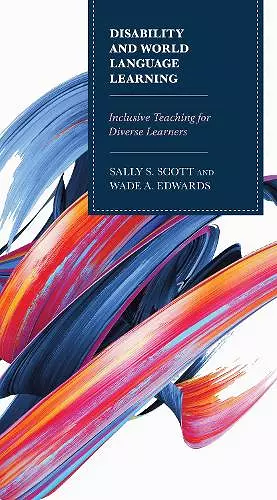Disability and World Language Learning
Inclusive Teaching for Diverse Learners
Wade Edwards author Sally Scott author
Format:Hardback
Publisher:Rowman & Littlefield
Published:12th Nov '18
Currently unavailable, and unfortunately no date known when it will be back
This hardback is available in another edition too:
- Paperback£30.00(9781475837056)

The release of a report by the Modern Language Association, “Foreign Languages and Higher Education: New Structures for a Changed World,” focused renewed attention on college foreign language instruction at the introductory level. Frequently, the report finds, these beginning courses are taught by part-time and untenured instructors, many of whom remain on the fringes of the department, with little access to ongoing support, pedagogical training, or faculty development. When students with sensory, cognitive or physical disabilities are introduced to this environment, the results can be frustrating for both the student (who may benefit from specific instructional strategies or accommodations) and the instructor (who may be ill-equipped to provide inclusive instruction). Soon after the MLA report was published, the American Council on the Teaching of Foreign Languages issued “Diversity and Inclusion in Language Programs,” a position statement highlighting the value of inclusive classrooms that support diverse perspectives and learning needs. That statement specifies that all students, regardless of background, should have ample access to language instruction. Meanwhile, in the wake of these two publications, the number of college students with disabilities continues to increase, as has the number of world language courses taught by graduate teaching assistants and contingent faculty. Disability and World Language Learning begins at the intersection of these two growing concerns: for the diverse learner and for the world language instructor. Devoted to practical classroom strategies based on Universal Design for Instruction, it serves as a timely and valuable resource for all college instructors—adjunct faculty, long-time instructors, and graduate assistants alike—confronting a changing and diversifying world language classroom.
Scott and Edwards fill an important gap in our understanding of inclusive pedagogies for todays’ diverse population of students. The integration of dual perspectives of a faculty member and a disability service provider is what makes this book unique and a must read for educators and parents alike. Today, when many are questioning the importance and ability of students with disabilities to learn a foreign language, this book guides the reader through case studies and evidence based Universal Design for Instruction practices, to answer some of these challenging queries around diverse profiles of learners and world language learning, in secondary and postsecondary institutions. -- Manju Banerjee, vice president, educational research and innovation, director, Landmark College Institute for Research and Training
Finally, a true-to-form guide for understanding world language students who have to deal with barriers in language learning. Inclusive should be a mainstay in the teacher’s acumen, as we all deserve the opportunity to learn, even when the learning is hard. Disability and World Language Learning meets the classroom teacher's needs by leading its users beyond just differentiated instruction. -- Dick Kuettner, romance languages and teacher education, Washington and Lee University, director, Global Discovery Laboratories
In an academic area where it is often assumed that disability means inability, Disability and World Language Learning opens the door to success for both students and instructors. This rare, research-based collaboration between a French professor and a campus disability resources administrator demonstrates how a focus on the accessibility of student experience can both preserve the integrity of disciplinary teaching and promote student learning. The exploration and application of principles of Universal Design for Instruction in the teaching of world languages in this work can serve as a model for how those principles can be actualized in the teaching of other academic disciplines. -- Elizabeth Harrison, University of Dayton, director, Office of Learning Resources, associate director, Ryan C. Harris Learning Teaching Center
All students can and should learn a second (or third!) language. Inclusive teaching practices help instructors anticipate and mitigate barriers for all students, not just those with disabilities. This approach has transformed the way that I teach Spanish and educate the next generation of language teachers. -- Susan Hildebrandt, Illinois State University, professor, applied linguistics and Spanish, coordinator, teacher education, ACTFL Board of Directors
ISBN: 9781475837049
Dimensions: 231mm x 160mm x 19mm
Weight: 349g
140 pages